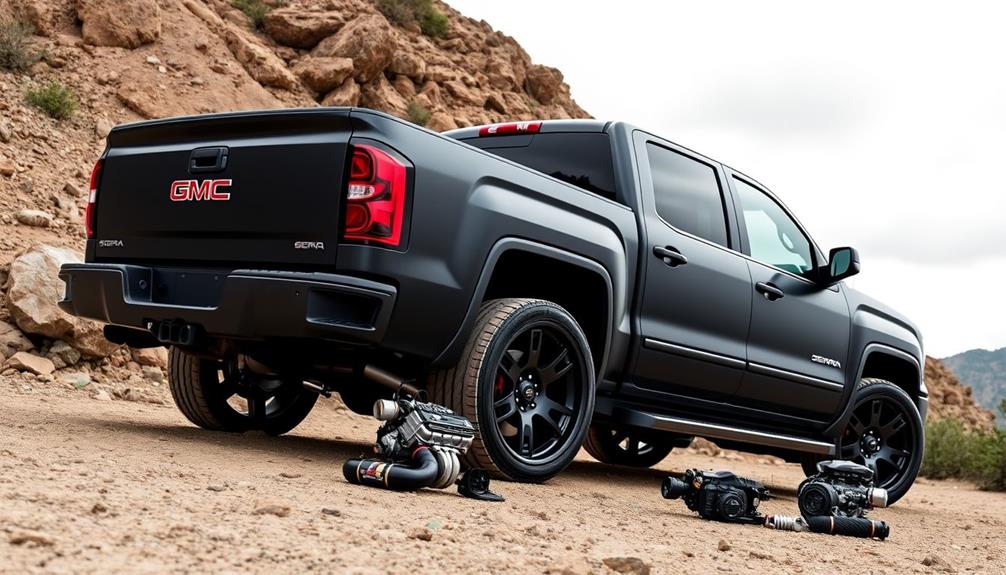Tuning your 2013 GMC Sierra can release its full power potential while maintaining its reliability. Start by upgrading performance parts like a cold air intake and a high-flow exhaust system; these alone can boost horsepower by up to 40. Custom tuning with a reliable programmer like BlackBear enhances throttle response and fine-tunes fuel maps for even greater gains. Don't forget to disable Displacement on Demand for smoother power delivery. Keep an eye on maintenance, as increased power can stress engine components. If you're keen to learn about further modifications and their benefits, there's plenty more to explore.
Key Takeaways
- Install a cold air intake to improve airflow and potentially increase power by up to 10% for the 5.3L V8 engine.
- Consider a high-flow exhaust system to reduce backpressure, adding 15-30 horsepower and enhancing engine sound.
- Utilize a performance chip to optimize fuel maps and shift points, yielding gains of 15-30 horsepower.
- Custom tuning, such as with BlackBear or Diablo Sport Trinity, enhances throttle response and allows for precise adjustments.
- Regular maintenance, including oil changes and air filter checks, is crucial for sustaining performance post-modification.
Overview of GMC Sierra 2013
When considering a truck that balances capability and comfort, the 2013 GMC Sierra 1500 stands out with its diverse engine options and trim levels. You can choose from three engines: a 4.3L V6 generating 195 hp, a 4.8L V8 producing 302 hp, or a powerful 5.3L V8 delivering 320 hp. This variety allows you to select the performance that best suits your needs, whether you're seeking fuel efficiency or robust power.
The Sierra 1500 comes in several trims, including Work Truck (WT), SLE, SLT, and Denali, so you can opt for utilitarian features or luxurious enhancements. Its towing capabilities are impressive, with a maximum capacity of up to 10,700 pounds when properly equipped. This makes it an excellent choice for those who regularly haul heavy loads.
You'll appreciate the standard six-speed automatic transmission that improves performance and fuel efficiency compared to older models.
Plus, with advanced safety features like StabiliTrak stability control and available parking assist, you can drive with confidence. The 2013 GMC Sierra combines performance, capability, and comfort, making it a top contender in the truck market.
Key Performance Modifications

To release the full potential of your 2013 GMC Sierra 1500, consider several key performance modifications that can noticeably enhance its power and efficiency.
First, upgrading to a cold air intake can improve airflow and combustion efficiency, resulting in a power increase of up to 10% for your 5.3L V8 engine.
Next, installing a high-flow exhaust system reduces backpressure, potentially adding 15-30 horsepower and 15-20 ft-lbs of torque to your ride.
Don't overlook the benefits of a performance chip. By optimizing fuel maps and shift points, you can achieve performance gains of 15-30 horsepower for both the 4.8L and 5.3L engines, along with improved throttle response.
Long tube headers also play a vital role in increasing exhaust flow, further enhancing power and sound, especially when paired with a cat-back exhaust system.
Choosing the Right Tuner

When you're choosing a tuner for your 2013 GMC Sierra, focus on compatibility with your planned upgrades, like a turbo or regear.
Custom tunes can greatly boost your truck's performance by optimizing power delivery and fuel efficiency.
Popular options like BlackBear and Diablew have proven effective, so be sure to research user reviews for insights on their reliability.
Tuner Compatibility Factors
Selecting the right tuner for your 2013 GMC Sierra involves understanding several compatibility factors that can considerably impact performance.
First, you need to take into account your engine type. Whether you have a 4.8L, 5.3L, 6.0L, or 6.2L engine, make sure the tuner is compatible with your specific configuration.
Next, think about your modifications. If you've installed a cold air intake or upgraded the exhaust system, custom tuning options become essential for maximizing performance.
Lastly, evaluate the tuning capabilities of your transmission. Generally, 6-speed transmissions allow for more extensive tuning adjustments compared to 8-speed models, which can affect how well your tuner performs.
Here's a quick checklist for tuner compatibility:
- Engine Type: Verify the tuner supports your specific engine size.
- Custom Tuning Options: Make certain it accommodates modifications for optimized performance.
- Transmission Compatibility: Check if the tuner can effectively manage your transmission type.
Custom Tune Advantages
Custom tuning offers significant advantages that can elevate your 2013 GMC Sierra's performance beyond standard tuning options. When you opt for custom tuning, you gain the ability to make precise adjustments to fuel maps and shift points, optimizing performance based on your truck's specific modifications.
Choosing the right tuner, like BlackBear or Diablew, allows you to enhance throttle response and overall drivability, guaranteeing your upgrades—such as cold air intakes and exhaust systems—work in harmony.
One of the key benefits of custom tuning is the ability to disable features like Displacement on Demand (DOD), which can improve power delivery and engine efficiency, particularly for modified engines.
Additionally, dyno tuning provides accurate performance assessments, enabling adjustments based on real-time engine data to maximize horsepower and torque.
Compatibility with your existing systems is vital. The right tuner guarantees that all modifications work seamlessly together, preventing potential conflicts and maintaining your vehicle's reliability.
Popular Tuner Options
There's a wealth of tuner options available for your 2013 GMC Sierra, making it crucial to choose the right one for your specific needs. Among the popular tuner options, two stand out: Black Bear and Diablo Sport Trinity. Both are highly regarded for their custom tuning capabilities, tailored to your modifications.
When selecting a tuner, consider these key factors:
- Customization: Confirm the tuner provides options to disable features like Displacement on Demand (DoD) for improved power delivery.
- User Experience: The Diablo Sport Trinity boasts a user-friendly interface, making it easier to navigate and apply changes.
- Compatibility: Verify that the tuner works seamlessly with your existing systems, particularly if you've made extensive modifications.
Custom tunes are crucial for maximizing your Sierra's performance, and dyno tuning is recommended for precise adjustments based on your vehicle's specific setup.
Ultimately, choosing between Black Bear and Diablo Sport Trinity will depend on your customization needs and how comfortable you're with tuning technology. Make an informed choice to release the full potential of your GMC Sierra!
Enhancing Fuel Efficiency

Upgrading your GMC Sierra 2013 for better fuel efficiency can be as straightforward as enhancing its airflow and optimizing engine performance. One of the best ways to achieve this is by installing a high-performance cold air intake system. This upgrade can improve airflow and potentially increase fuel economy by 5-10%, allowing your engine to breathe easier and utilize fuel more effectively.
Another effective method is custom tuning, which can include disabling Displacement on Demand (DoD). This adjustment reduces unnecessary engine cycling, optimizing power delivery and enhancing fuel economy based on your driving conditions.
Implementing a performance chip can also make a significant difference. By recalibrating fuel maps, a performance chip may improve your miles per gallon (MPG) while boosting horsepower by 15-30hp in 5.3L engines.
Don't forget the importance of regular maintenance, too. Clean air filters and properly inflated tires are essential for maximizing fuel efficiency, as clogged filters and low tire pressure can decrease MPG by up to 10%.
Choosing a tuner that accommodates your existing upgrades helps balance performance gains with fuel economy, ensuring you get the best of both worlds.
Community Insights and Experiences

Many GMC Sierra 2013 owners have shared their tuning experiences, revealing a wealth of insights that can guide others looking to enhance their trucks. When tuning your GMC Canyon 2005, it’s important to consider the specific needs and goals for your vehicle. Some owners have found success with adding a cold air intake and performance exhaust for increased horsepower and torque, while others have focused on suspension upgrades for improved off-road capabilities. It’s important to research and plan your tuning strategy carefully to ensure you achieve the desired results for your GMC Canyon 2005.
Many drivers report that custom tunes from brands like BlackBear or Diablew have markedly improved throttle response and overall performance. Community forums also discuss the advantages of specific modifications, emphasizing how simple changes can lead to powerful results.
Here are three key takeaways from the community:
- Delete Displacement on Demand (DoD): This modification can boost both performance and fuel efficiency, making your driving experience much more engaging.
- Cold Air Intakes and Cat-Back Exhausts: Users frequently mention how these upgrades contribute to noticeable horsepower gains and a more satisfying engine sound.
- Dyno Tuning: Many enthusiasts recommend dyno tuning for precise performance assessments and tailored adjustments based on your vehicle's unique modifications.
Selecting compatible tuners is essential.
Many Sierra owners stress the importance of ensuring that your tuning setup can handle extensive modifications, maintaining reliability while maximizing performance.
Recommended Tuning Options

When it comes to tuning your 2013 GMC Sierra, several options stand out for delivering impressive performance gains. Custom tuning solutions like BlackBear and Diablew are highly recommended, as they provide tailored enhancements specific to your modifications. For those with 4.8L and 5.3L engines, utilizing an AutoCal Tune & Hardware can yield 15-30hp gains and improved shift patterns.
Here's a quick overview of some effective tuning options:
| Tuning Option | Performance Gain |
|---|---|
| Custom Tuning (BlackBear, Diablew) | Tailored enhancements |
| AutoCal Tune & Hardware | 15-30hp, better shifts |
| Hand-held Tuners | Adjust fuel maps, driveline behavior |
Hand-held tuners let you tweak fuel maps and driveline behavior, customizing your truck's performance for specific needs, like towing or improving fuel economy. While tuning can disable Displacement on Demand (DoD) or Dynamic Fuel Management (DFM), it often enhances power delivery and efficiency for your modifications. For the best results, consider dyno tuning to guarantee your setup is optimized for your specific engine and aftermarket components.
Risks of Performance Modifications

When you modify your GMC Sierra for performance, you need to be aware of the potential legal compliance issues that could arise.
These modifications can also void your warranty, leaving you responsible for costly repairs if something goes wrong.
Additionally, increased performance often comes with reliability concerns that could affect your truck's longevity.
Legal Compliance Issues
While performance modifications can enhance your GMC Sierra's power and efficiency, they can also expose you to significant legal risks. Many enthusiasts overlook legal compliance issues, especially when it comes to emissions testing. Ignoring these regulations can lead to costly fines and headaches.
Here are three essential points to take into account before making any modifications:
- Emissions Regulations: Deleting emissions-related systems, like catalytic converters, may violate federal and state laws, resulting in hefty penalties.
- Emissions Testing: Many states require vehicles to pass emissions testing. Modifications that affect emissions systems might cause your truck to fail these assessments.
- Legal Consequences: Tampering with emissions equipment could lead to not just fines, but also vehicle impoundment or mandatory repairs.
Taking the time to research local laws and understand the implications of your performance modifications is vital.
It's better to enjoy your GMC Sierra's enhancements without facing unexpected legal repercussions. Always prioritize compliance to keep your truck performing well and legally on the road.
Warranty Voiding Risks
Modifying your GMC Sierra for better performance can greatly enhance your driving experience, but it also comes with the risk of voiding your manufacturer's warranty.
Performance modifications like engine tuning, cold air intakes, and exhaust upgrades can lead to warranty voiding if they cause engine failure or related issues. While the Magnuson-Moss Warranty Act requires manufacturers to prove that a modification directly caused the problem to deny a claim, maneuvering this can be tricky for you as a consumer.
Moreover, deleting emissions-related systems may boost performance, but it not only risks warranty voiding but could also result in legal troubles due to environmental regulations.
Many aftermarket tuners and enhancements often lack certification from your vehicle's manufacturer, making it easier for warranty claims to be denied if something goes wrong post-modification.
To safeguard your warranty, it's essential to document all modifications and communicate openly with your dealership.
Understanding the potential impacts of your choices on warranty coverage will help you make informed decisions while still enjoying the enhancements you desire for your GMC Sierra.
Reliability Concerns
Performance modifications can considerably impact the reliability of your GMC Sierra, particularly if they push the vehicle beyond its designed limits.
While performance upgrades can enhance your truck's power, they often bring reliability concerns that you can't ignore. Here are a few risks to take into account:
- Increased Wear: Significant power output boosts, like forced induction, can lead to accelerated wear on engine components, potentially shortening its lifespan.
- Drivetrain Strain: Higher horsepower and torque can strain the drivetrain, risking failures in transmission and differential systems if they aren't upgraded to handle the extra load.
- Temperature Management: Performance upgrades often raise operating temperatures. Without effective cooling solutions, you risk overheating, which can lead to serious engine failure.
To maintain your truck's reliability post-modification, regular maintenance becomes essential.
This guarantees all components are operating at their best and can help mitigate any reliability concerns stemming from increased performance demands.
Maintenance for Optimal Performance

To keep your 2013 GMC Sierra running at its best, regular maintenance is vital. Start with oil changes every 5,000 to 7,500 miles to guarantee peak engine lubrication and performance.
Clean and replace your air filter every 15,000 to 30,000 miles to maximize airflow to the engine, improving throttle response and fuel efficiency.
Don't forget to check your spark plugs, especially if you have iridium plugs, which should be replaced around 100,000 miles. This helps maintain peak ignition performance.
Inspect your brake components regularly, as worn pads and rotors can negatively impact your stopping power and overall driving experience.
Maintaining fluid levels is important, too. Keep an eye on your coolant, transmission fluid, and power steering fluid to prevent performance issues and enhance the longevity of your GMC Sierra's engine and systems.
Future Upgrades and Considerations

After ensuring your GMC Sierra is well-maintained, it's time to reflect on future upgrades that can elevate its capabilities even further.
Here are three key modifications to take into account:
- Forced Induction: Investing in a turbocharger system can greatly enhance your truck's power output and performance. This upgrade allows you to harness more horsepower, making your Sierra even more capable.
- Air Intake System: Installing a cold air intake system can boost engine performance by providing denser air for combustion. This simple modification can potentially increase horsepower by up to 10%, giving you that extra edge.
- Custom Tuning: After making modifications, don't overlook the importance of custom tuning. A reputable tuner like BlackBear or DiabloSport can optimize your performance settings, ensuring a balance between power and fuel economy tailored to your upgrades.
Frequently Asked Questions
How Can I Get More Horsepower Out of My 5.3 GMC Sierra?
To boost horsepower in your 5.3L engine, consider upgrading to a cold air intake, installing long tube headers, adding a performance exhaust system, and utilizing custom tuning with a performance chip or programmer.
How Can I Make My 2013 GMC Sierra Faster?
Ever wondered how to release your truck's potential? To make your 2013 GMC Sierra faster, consider installing a cold air intake, upgrading the exhaust, and using a performance chip. These tweaks can greatly boost your speed!
How Many Miles Will a 2013 GMC Sierra 1500 Last?
A well-maintained 2013 GMC Sierra 1500 can easily last over 200,000 miles, with many owners reporting 300,000 miles or more. Regular maintenance and care are key to maximizing its longevity and performance.
How Much Horsepower Does a 2013 GMC Sierra 1500 Have?
When it comes to horsepower, you've got options with the 2013 GMC Sierra 1500. It ranges from a robust 195 in the V6 to a powerful 403 in the 6.2L V8. Choose your beast wisely!
Conclusion
To sum up, tuning your 2013 GMC Sierra can elevate its performance without sacrificing reliability. You might worry about potential risks, but with the right modifications and a careful approach, you can enhance both power and efficiency. Embrace the thrill of a tuned engine while maintaining your truck's dependability. Don't hesitate to explore the community insights and recommended options; you'll find a wealth of support and knowledge to help you make the best choices for your ride. When it comes to tuning your GMC Sierra single cab, it’s important to consider the specific needs and goals for your vehicle. Whether you prioritize towing capabilities, off-road performance, or simply want to maximize fuel efficiency, there are various tuning options to suit your preferences. By consulting with experts and fellow enthusiasts, you can make well-informed decisions to optimize your truck’s potential. With the right tuning, your 2013 GMC Sierra single cab can truly become a customized powerhouse on the road.










